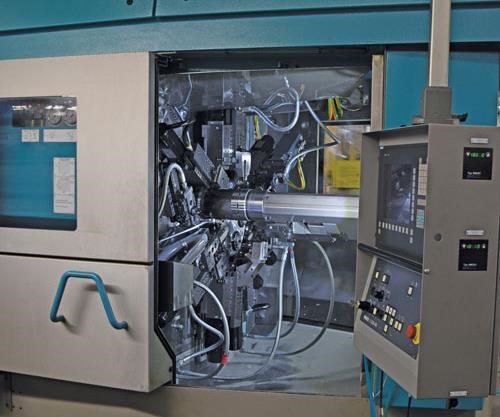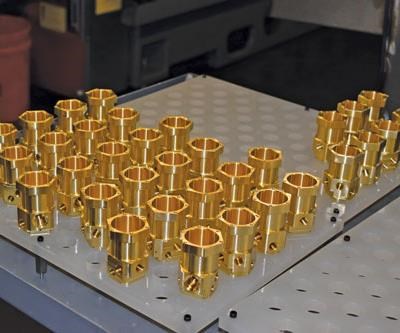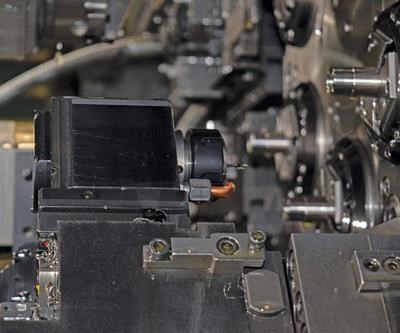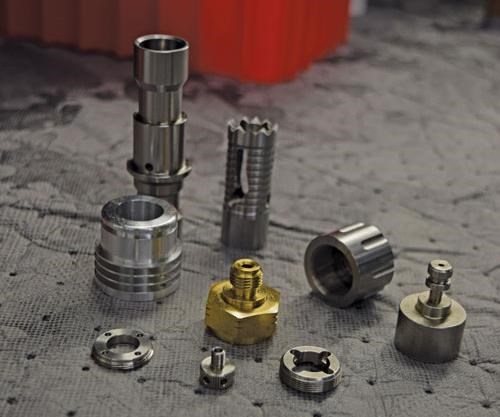Making Complex Parts Profitably
In a highly competitive global market, finding ways to manufacture domestically and profitably is an ongoing challenge. This Massachusetts shop has found a way using CNC multi-spindles.
In his 42 years in metalworking, Jake Grainger, owner of Alpha Grainger (Franklin, Massachusetts) has seen huge changes in the business over the past 4 decades. “Over 7 million manufacturing jobs have been transferred to Asia since I started in 1973,” he says. “With the exception of aerospace and medical, I’ve seen metalcutting manufacturing here in Massachusetts decline significantly. In general, there is either a strategic reason for making it here, or it is what I call protected work: firearms, defense or expensive mechanical devices. Most commodity part work is gone.”
Like many industry veterans, change is understood to be part of the business. Survivors have found ways to identify and win what work was left here in this country. For Alpha Grainger, it’s the tough, complex parts that are too much of a challenge for most shops that may be accustomed to simple work. For shops such as Alpha Grainger to stay in business, it needs to be able to go after the work successfully and profitably.
In evaluating the machine tool options, Mr. Grainger, who includes chief technology officer among the hats he wears, identified CNC multi-spindle machines as a way to win domestic jobs for his shop. “Multi-spindle CNCs let us complete a part with many small details and features in 10 percent of a single-spindle lathe cycle time,” he says.
“I think of the multis as a multi-spindle milling machine with lathe capability rather than a turning machine. We have a hard time winning jobs that are only turning. We need ‘stop-spindle’ work; if it is only straight turning, someone else will win it. It’s brutal. There is a dog fight for the simple work: drilling, tapping, turning,” he continues.
Go Large or Go Home
After some intensive research, Mr. Grainger zeroed in on Index CNC multi-spindles as the brand around which to build his CNC multi department. The company has three MS 40 machines, which are six-spindle CNC multis.
Late last year, Alpha Grainger took delivery its first CNC eight-spindle machine. By the end of this year, the shop will have a total of four, eigh-spindle MS22-8 multis. “I decided to buy four of the 22-8s at once because we felt we had to make the investment to get that leap ahead—not one now and another in a couple months and another in 9 months. Our decision was to bring in technology immediately,” Mr. Grainger says.
Echoing the industry-wide lament, Mr. Grainger says finding skilled workers is a problem for Alpha Grainger, too. “Middle-class families don’t honor factory jobs, and the K-12 schools often ignore kids with mechanical talent. We try to identify people with mechanical talent and a great place to look for them is in the automotive technician area. They don’t know about metalcutting, but usually can easily learn it.”
Mr. Grainger recalls that at first, CNC multis can be a bit intimidating. But he also finds that most new people will try to learn the machine as they are unwilling to show they are not up to the challenge. “The Index takes a well-trained person to run it, so unless you build that kind of capability in your precision shop, you won’t compete successfully.”
What Kind of Work Works?
The Index MS22C-8, a modular eight-spindle machine, opens up additional opportunities for already quick multi-spindle parts machining, especially highly complex parts for the automotive, defense, aerospace, mechanical, and medical industries. It also produces small batches efficiently and economically—bar-fed or loaded with chucked parts.
When Mr. Grainger finds a part that will fit in the 7/8 inch capacity of the MS22-8, he can usually win the job because of the cycle time. Some of the parts he quotes are complex, and he often used the shop’s 3D printer to make a sample so that it’s easier to understand the part and its features.
A main competitive advantage to the MS22-8 is that it can be configured to operate as an eight-spindle machine or a double four-spindle machine, dropping two complete parts at a time using double backwoking machining.
The use of creative tooling to accomplish multiple operations in a single spindle is also a key advantage of the CNC multis. The MS22 hits a sweet spot for parts less than 1-inch diameter, and because of the eight-spindle capability, Alpha Grainger can win work Mr. Grainger never thought it could.
Backworking and Double Drop
With two pickoff spindles, 22-8 can run as a conventional eight-spindle machine using only one pickoff in position 8. Or it can be run as two completely independent four-spindle machines, which can be configured as a double pickoff eight-spindle machine that provides for double the backworking time. This opens the door to being competitive on parts that have a lot of sub spindle work.
This extra backwork would normally slow the machine down, but with double the time, most jobs can be completed within the main spindle cycle time. There are six tools available for backwork, and two of them can be rotating tools. With this advantage, Mr. Grainger says we have never had to slow a job down for the subspindle work.
It’s surprising how many part geometries can be run on a four-spindle multi. That capability of double-four machining gives that advantage. The MS22C-8 in double four-spindle mode actually runs as two machines working within one cabinet on a single base.
Spindles 1, 3, 5 and 7 are one machine, and the even numbered spindles are the other machine. Each has its own pickoff spindle and part conveyor, can make different parts at the same time and will keep them separated. When working in the double four mode, the spindle drum double indexes so that a part will only be processed by the even or odd positions. Two parts are dropped for every spindle drum index.
“We have three main spindles with the fourth being cut off and backworked,” Mr. Grainger says. “There are two cross-slides for each of the three main spindles, and each of these cross-slides can take gang tooling. With six cross-slides each taking multiple tools, you’re very likely to be able to make your parts in the double four mode.”
Running as Eight
The MS22C-8 can perform turning, off-center drilling and thread cutting, inclined and cross-drilling, milling, multi-edge turning, hobbing, tooth milling, deep-hole drilling or slotting. Another benefit is that all standard toolholders and toolholder system interfaces can be used with a range of adapters.
Each of the eight spindles, arranged in the well-known Index spindle drum, are assigned two cross-slides, which can travel both on the X as well as on the Z axis. As for Y axis, Mr. Grainger says, “There are limits to which positions can have a Y axis although all slides can have an interpolated Y axis function. It’s not the same as a Y axis, but can do a lot of Y axis work. Additionally, each cross-slide can be equipped with a Y axis.”
The speed of each of the eight liquid-cooled spindles can be controlled independently. The fluid-cooled spindle drum keeps the thermal growth in the spindle carrier to a minimum, resulting in higher power density in the spindle drum and the ability to recover the heat energy from the cooling fluid. The spindle bearing temperature can thus be kept at a low level, which also prolongs service life and improves thermal stability.
The Index multis avoid thermal expansion with a
40-kW chiller.
The cross-slides with integrated drives have a low-mass design with hydrostatic bearing support. Their low moment of inertia and resulting high dynamics facilitates outstanding acceleration in operation.
In double backworking, there are six main spindle positions available for front machining the workpiece and two subspindle positions for backworking, and they all work simultaneously. With this approach, backworking of a workpiece occurs during two drum indexing cycles.
Parts are completed in the first six front work positions, and when there is a complete part in both positions 7 and 8, both subspindles come in together and grab a part. Then there are two part cycle times available to do backworking before positions 7 and 8 have parts that need to be picked up again.
Double-Four in Practice
At Alpha Grainger, Jake and his crew are making a lot of progress using the MS22-8 as a double-four multi-spindle.
“Now I have four CNC cross-slides that can do almost any operation you need, so it opens the door to a huge amount of product that I can make in the double-four configuration,” Mr. Grainger says. “All of a sudden, I can compete on work that I thought previously was too cheap or low cost. One of our multis is set up for a valve body. We beat the Chinese supplier on that product using the double-four configuration. I call that ‘proof of concept’.”
Design Features for Consistent Machining
The advantage of hydrostatic sliding guide in the feed axis (Z) is the outstanding damping characteristic that prevents the transfer of the machining vibrations to the adjacent slide via the headstock. This helps to mitigate vibration and rattling while workpieces are being machined—even when the most diverse machining processes are being performed concurrently by the eight spindles.
One spindle can be used for heavy duty roughing, while high precision finishing takes place on another spindle without sacrificing surface quality. In addition, the hydrostatic bearing is wear-free—there is neither friction nor a stick-slip effect. The hydrostatic bearings are supplied with chilled hydraulic fluid, which keeps the whole main casting at a constant temperature and this virtually eliminates thermal growth of the parts being produced.
The swiveling synchronous spindles are locked into the end positions by three-part Hirth couplings. The high level of stiffness that this achieves also guarantees that even with bar diameters up to 24 mm, backworking operations with high cutting volumes, and simultaneously high machining precision can be performed.
The Hirth coupling also means it is no longer necessary to electronically compensate at the end position. The mechanical lock ensures optimal stiffness and increases the positioning accuracy. This allows even highly complex components to be produced that require complex cut-off side machining. The swivel movement to the backworking position occurs in less than 0.3 second.
Discharging workpieces damage-free from the work area and placed on pallets in the right position for later treatment, the MS22C-8 can include optional handling solutions: machine-integrated handling with external stacking unit that ensures careful removal of parts from the machine, including measuring operations for the workpieces, if needed. Workpiece data can be fed back directly to the machine control, so it can automatically correct its machining parameters.
The decision to invest in multi-spindle CNCs was a big one for Alpha Grainger, but Jake Grainger’s vision of the future of precision parts manufacturing required nothing less.
Related Content
Where Machining Precision is a Family Tradition
This century-old manufacturer is a case in point of how company culture and openness to adopting new technology paves the way to success.
Read MoreDN Solutions Announces Twin-Spindle, Twin-Turret Horizontal Turning Center
IMTS 2024: DN Solutions introduces a twin spindle, twin-turret horizontal turning center with 4″ bar capacity for increased productivity and simultaneous machining performance.
Read MoreStriving for Faster Changeovers for Multispindles
A multispindle platform designed to combine the high production speed of a cam-driven machine with the precision and repeatability of CNC also includes technology to speed set ups for new jobs.
Read MoreUpgrading Bar Feeder Components with Metal 3D Printing
Index is exploring redesigning and optimizing parts for bar feeders inside its multi-spindle turning centers using a low-cost metal 3D printing platform from One Click Metal.
Read MoreRead Next
A Tooling Workshop Worth a Visit
Marubeni Citizen-Cincom’s tooling and accessory workshop offers a chance to learn more about ancillary devices that can boost machining efficiency and capability.
Read MoreEmerging Leaders Nominations Now Open
Here’s your chance to highlight a young person in your manufacturing business who is on the path to be a future leader moving your company forward.
Read More5 Aspects of PMTS I Appreciate
The three-day edition of the 2025 Precision Machining Technology Show kicks off at the start of April. I’ll be there, and here are some reasons why.
Read More












.jpg;maxWidth=300;quality=90)





.jpg;maxWidth=300;quality=90)








